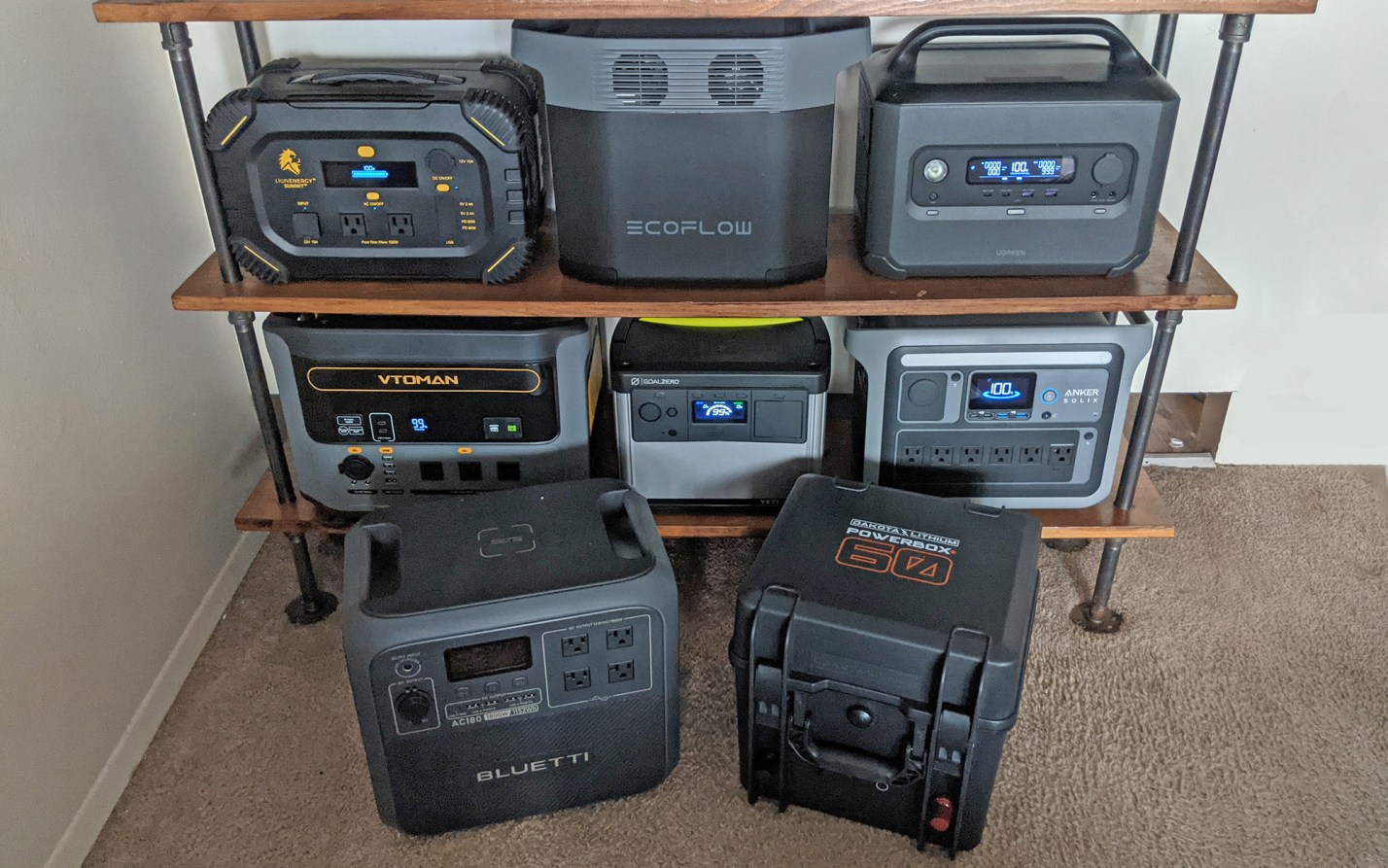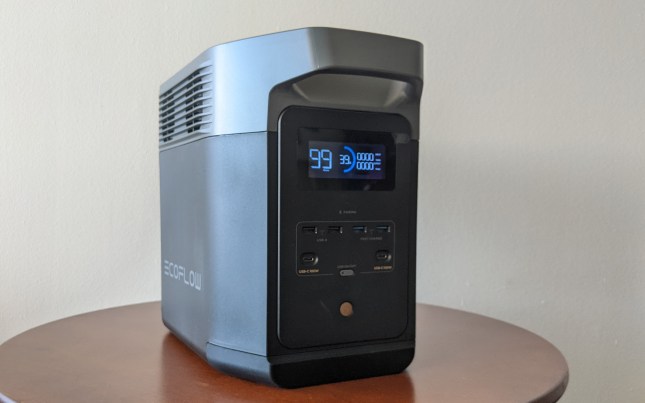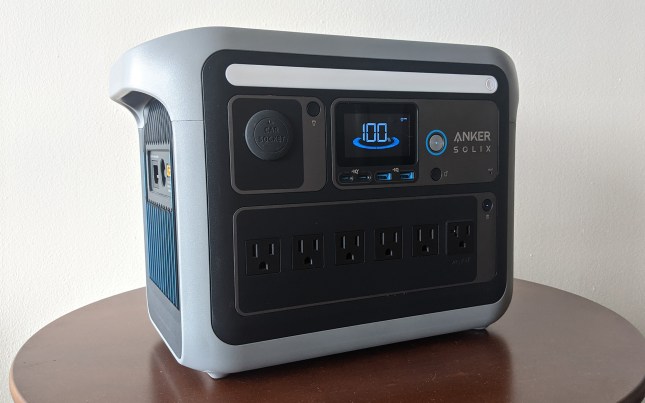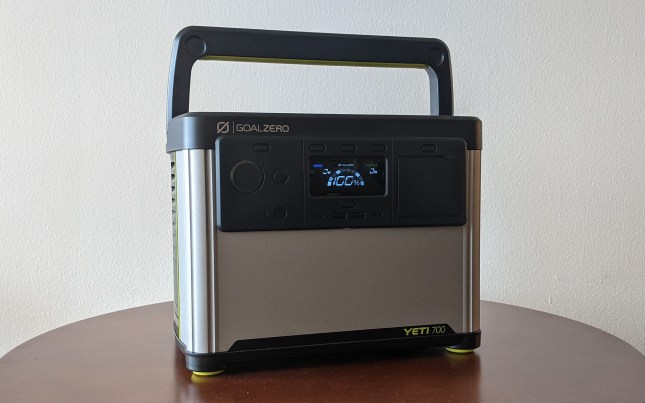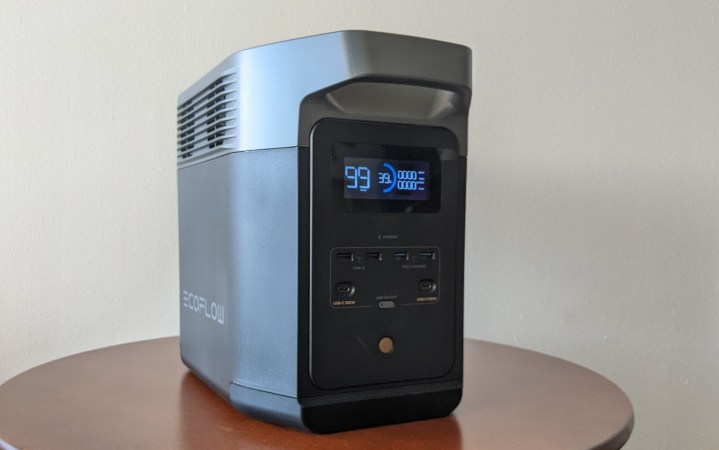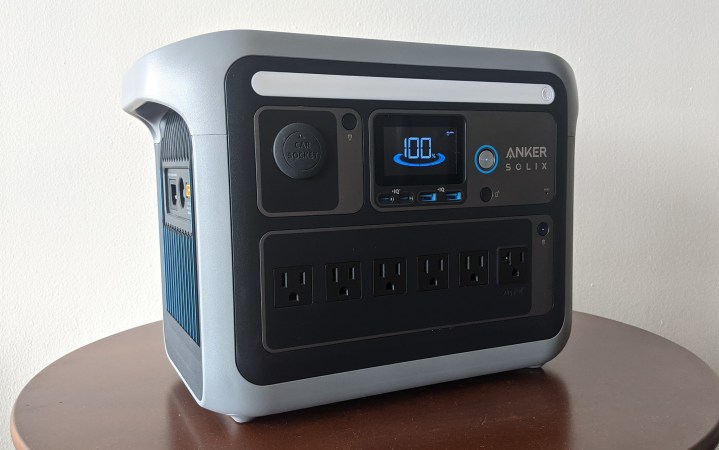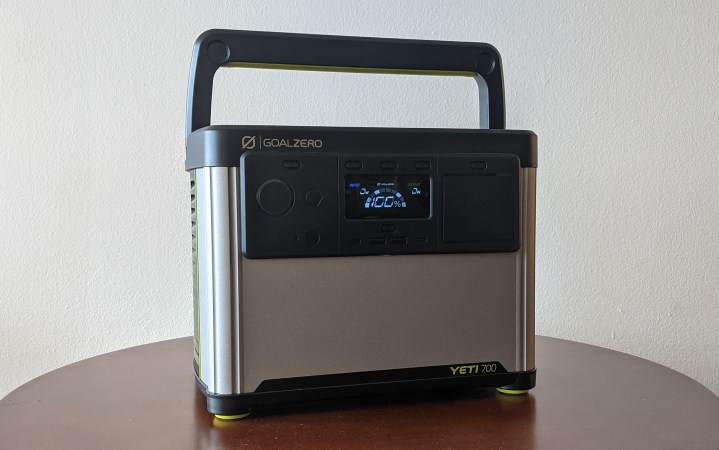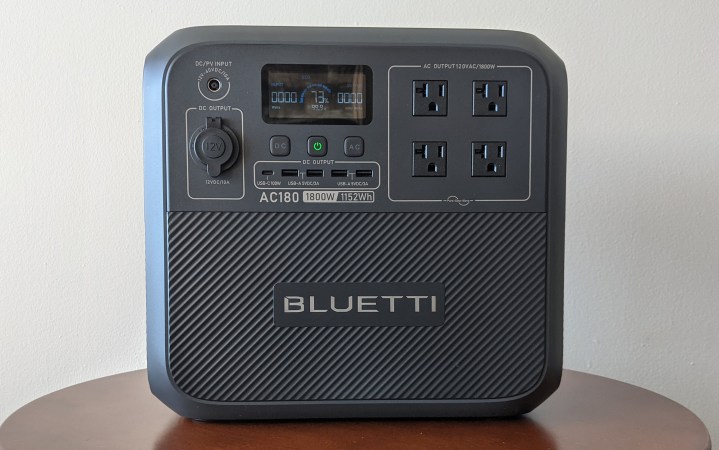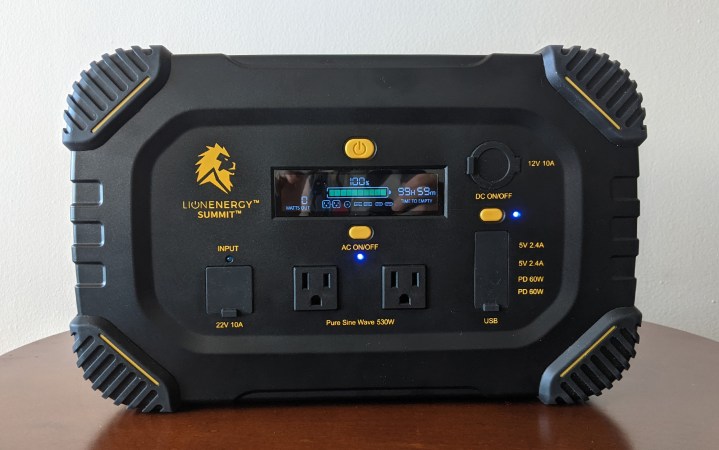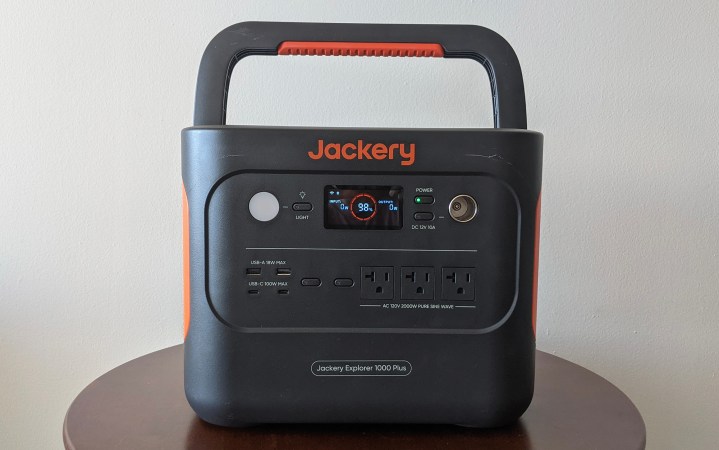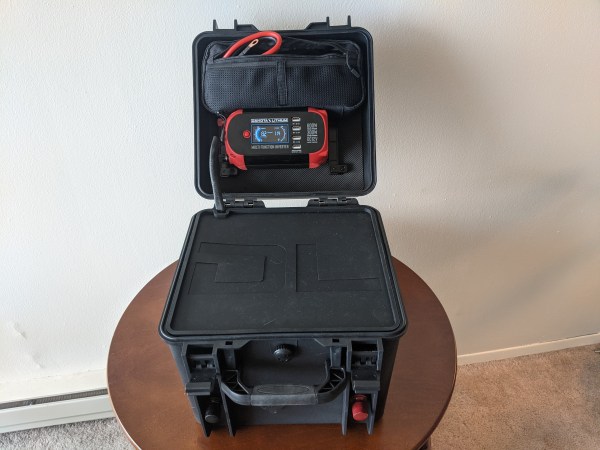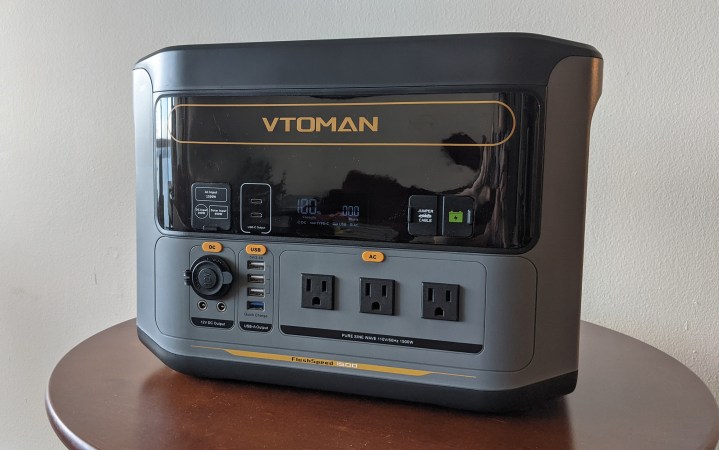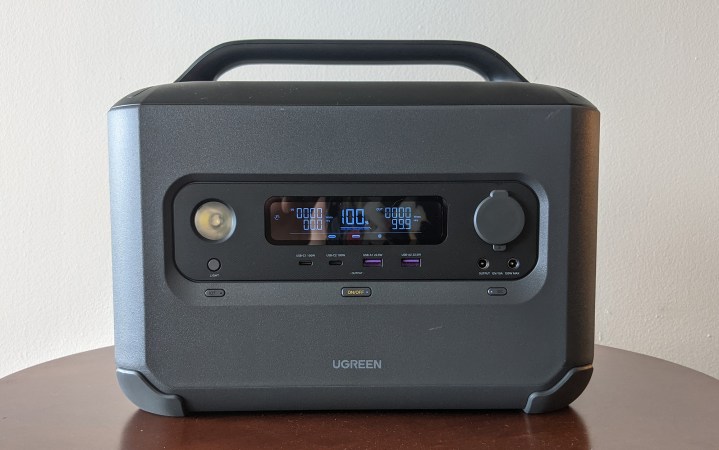We may earn revenue from the products available on this page and participate in affiliate programs. Learn More ›
Portable power stations are more powerful and cost effective than ever before. And, thanks to advances in lithium-ion battery technology, they’re also lighter and more compact. Whether you’ve been dreaming of van life or are building out your emergency kit in advance of that next blackout, there are various options on the market to meet your needs. To help you decide, I tested the efficiency, in a variety of scenarios, of the best portable power stations from EcoFlow, Anker, Goal Zero, Bluetti, Dakota Lithium, Lion Energy, Vtoman, and Ugreen.
Best Overall: Ecoflow Delta 2
↓ Jump to Review
Best for Solar Generators: Anker SOLIX C1000
↓ Jump to Review
Most Reliable: Goal Zero Yeti 700
↓ Jump to Review
Best for High-Watt Appliances: Bluetti AC180
↓ Jump to Review
Most Efficient: Lion Energy Summit
↓ Jump to Review
Easiest to Use: Jackery Explorer 1000 Plus
↓ Jump to Review
Dakota Lithium PowerBox + 60 Waterproof Power Station
↓ Jump to Review
Vtoman FlashSpeed 1500
↓ Jump to Review
Ugreen PowerRoam
↓ Jump to Review
↓ Jump to What to Know Before Purchasing a Portable Power Station
How I Tested the Best Portable Power Stations
I’ve been testing portable power stations for years as part of my ongoing test of the best solar generators. In that time I’ve noted the features that matter most for home emergencies and off-grid excursions, and where different brands and models struggle with reliability and efficiency. As I played around with these units, two main questions came into focus: Do these power stations really hold as much energy as they say they do? And how much of that energy is leaking out whenever I turn them on?
The Test Line Up
For this test, I called in units from Goal Zero, Bluetti, Vtoman, Anker, Jackery, Dakota Lithium, Ugreen, EcoFlow, and Lion Energy.
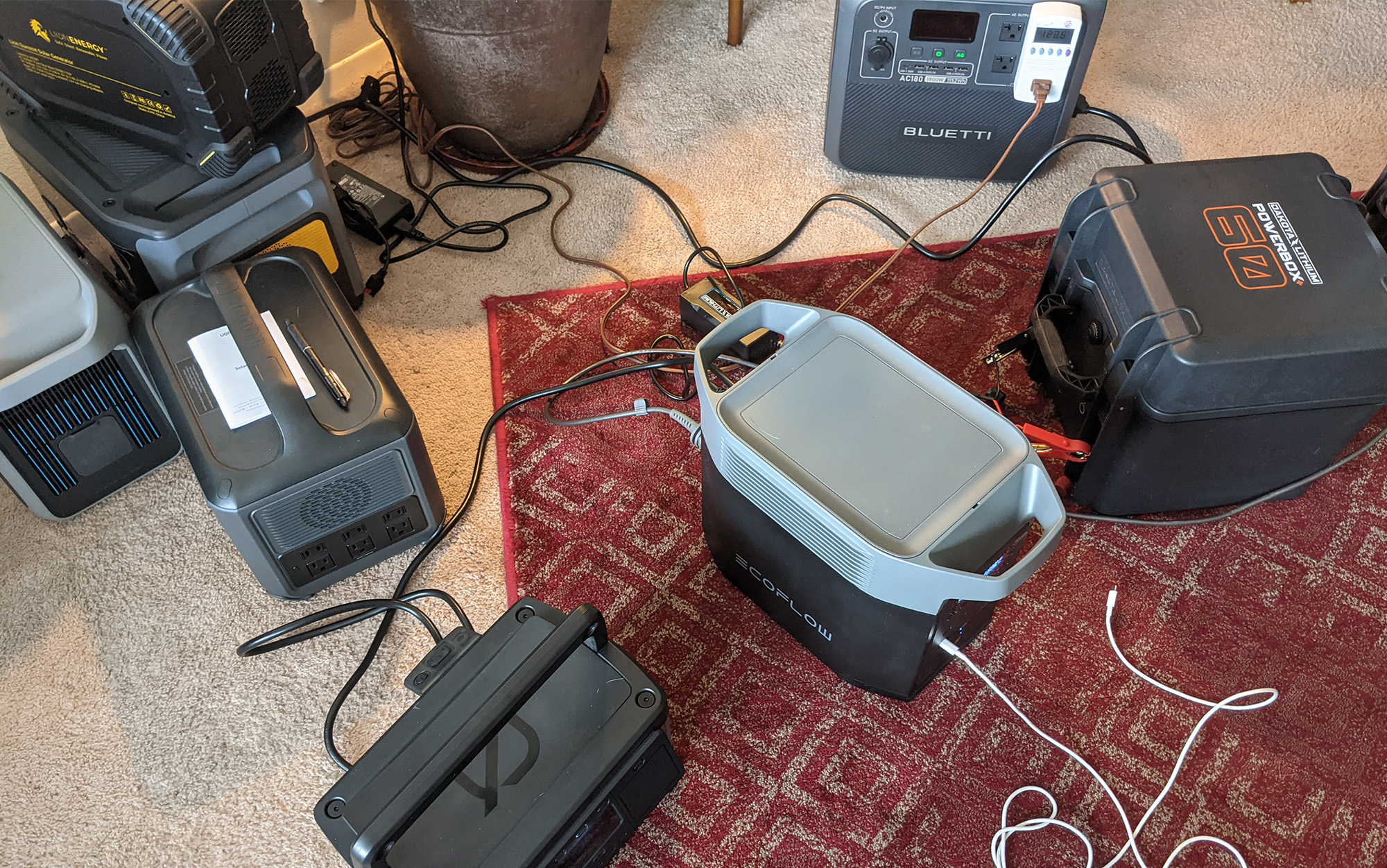
Laura Lancaster
Useable Watt Hours
The most important criteria in my testing protocol was verifying the usable number of watt hours in a fully charged power station against its stated number of watt hours. I ran two tests on this. The first used one of the AC ports to run a grow light (for my orange and lemon trees), which uses about 34 watts. This test most closely simulates what you’d experience if you were purchasing a power station as a backup power source for your CPAP machine, refrigerator, television, or laptop. During this time, I measured both the number of watt hours used and the length of time the light was on using a Kill-a-Watt meter.
| Power Station | Retail Price | Weight | Warranty | Battery Chemistry | Lifecycles | Max Solar Input |
| Anker SOLIX C1000 | $1000 | 28.5 lbs | 5 years | LiFePO4 | 3000 | 600W |
| Bluetti AC180 | $1000 | 37 lbs | 5 years | LiFePO4 | 3500 | 500W |
| Dakota Lithium PowerBox + 60 Waterproof Power Station | $900 | 27 lbs | 11 years | LiFePO4 | 2000 | N/A |
| Ecoflow Delta 2 | $1000 | 27 lbs | 5 years | LiFePO4 | 3000 | 500W |
| Goal Zero Yeti 700 | $600 | 20.9 lbs | 5 years | LiFePO4 | 4000 | 200W |
| Jackery Explorer 1000 Plus | $1200 | 32 lbs | 5 years | LiFePO4 | 4000 | 800W |
| Lion Energy Summit | $600 | 18 lbs | 5 years | LiFePO4 | 3500 | 100W |
| Ugreen PowerRoam | $1000 | 25.4 lbs | 5 years | LiFePO4 | 3000 | 400W |
| Vtoman FlashSpeed 1500 | $1600 | 41.5 lbs | 5 years | LiFePO4 | 3100 | 400W |
What’s important to know here is that the AC port, when it’s turned on, leaks more energy than the USB or DC ports. So if you only plan to use a power station to charge your laptop or smartphone, you will likely have better results than experienced in this test (assuming you use the USB ports). Campers are also less likely to use the AC port compared to the DC or USB ports.
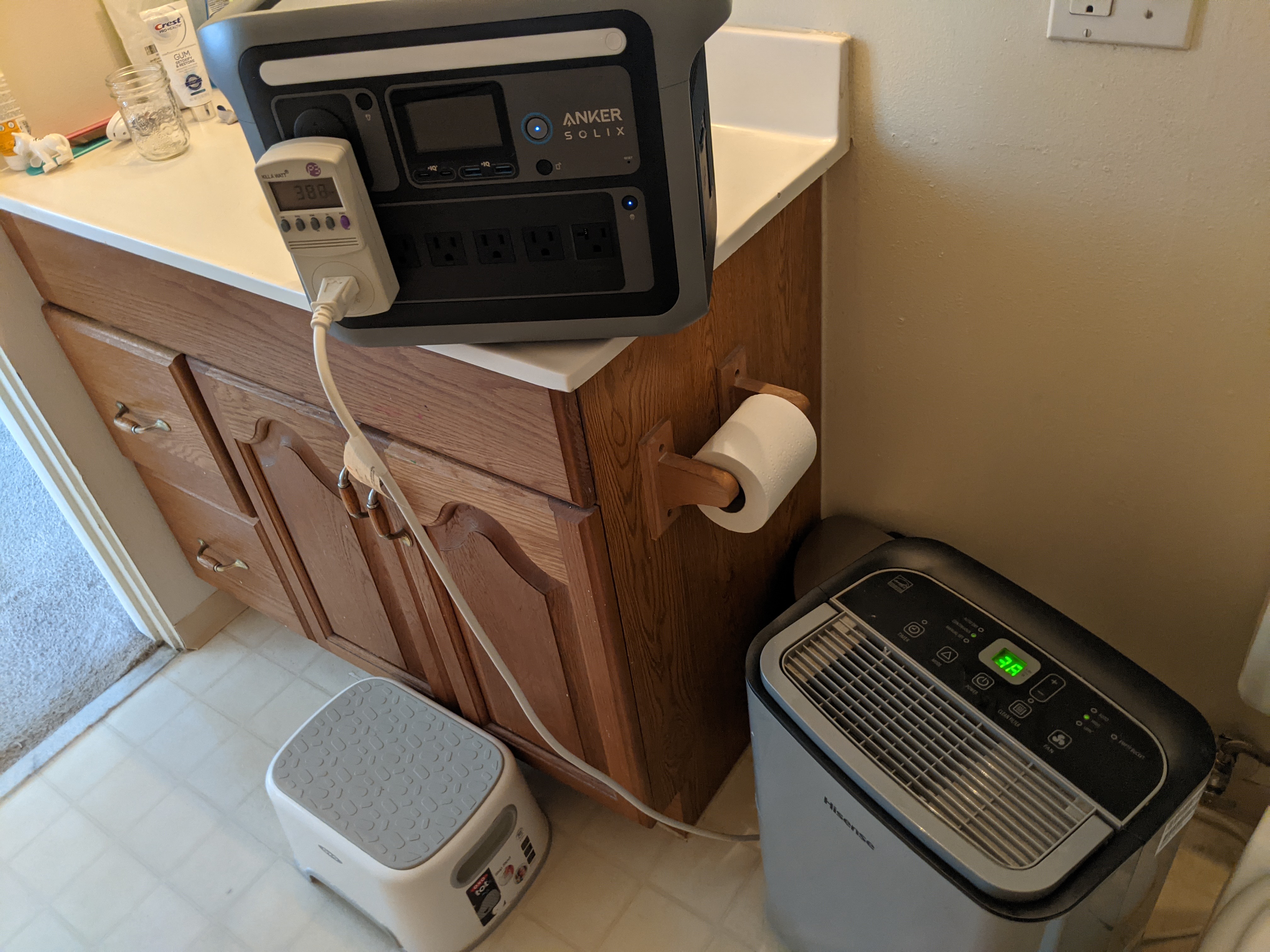
Laura Lancaster
For the second test, I used each fully charged power station to run a dehumidifier (which uses about 380 watts on high). As expected, this ran down each power station fairly quickly, typically in a couple of hours. However, that meant that less power overall was lost to the inverter itself, increasing the overall efficiency recorded for each power station.
| Power Station | Price | Stated Watt Hours (Wh) | Timed Test at ~34W Draw (Grow Light) | Timed Test at ~380W Draw (Dehumidifier) | Watts Used by Inverter and AC Port | Tested Claimed Max Wattage | Time to Recharge | IP Rating |
| Anker SOLIX C1000 | $1000 | 1056 Wh | 650 Wh 17.3 hours 62% of stated Wh | 950 Wh 2.6 hours 90% of stated Wh | Unavailable | 1800W | 1.4 hours | None |
| Bluetti AC180 | $1000 | 1152 Wh | 620 Wh 15.1 hours 54% of stated Wh | 980 Wh 2.7 hours 85% of stated Wh | 14W | 1800W | 1.3 hours | None |
| Dakota Lithium PowerBox | $900 | 720 Wh | 460 Wh 12.7 hours 63.9% of stated Wh | Unable to test | 2.4W | 300W | 6+ hours | IP67 |
| Ecoflow Delta 2 | $1000 | 1024 Wh | 690 Wh 18.6 hours 67% of stated Wh | 900 Wh 2.3 hours 88% of stated Wh | 10W | 1800W | 1.3 hours | IP20 |
| Goal Zero Yeti 700 | $600 | 677 Wh | 480 Wh 13.4 hours 70% of stated Wh | 560 Wh 1.5 hours 83% of stated Wh | 9W | 600W | 2 hours | IPX4 |
| Jackery Explorer 1000 Plus | $1200 | 1265 Wh | 620 Wh 16.5 hours 49% of stated Wh | 1090 Wh 2.9 hours 86% of stated Wh | Unavailable | 2000W | 1.8 hours | None |
| Lion Energy Summit | $600 | 665 Wh | 480 Wh 13.5 hours 72% of stated Wh | 570 Wh 1.6 hours 86% of stated Wh | 13W | 530W | 4.8 hours | None |
| Ugreen PowerRoam | $1000 | 1024 Wh | 690 Wh 18.5 hours 67% of stated Wh | 880 Wh 2.2 hours 85% of stated Wh | 30W | 1200W | 1.1 hours | None |
| Vtoman FlashSpeed 1500 | $1600 | 1548 Wh | 770 Wh 21.9 hours 49.7% of stated Wh | 1219 Wh 3.4 hours 78% of stated Wh | 4W | 1500W | 1 hour | None |
Recharge Time and Max Wattage
I additionally checked how long it took to recharge each unit, and verified that it was capable of hitting the max wattage output claimed by plugging various appliances and other power stations into each one.
Other Considerations
I also queried manufacturers on the amount of power used by the power station when it is on and the AC ports are activated, the numbers for which are provided in the above table. Finally, I drilled down on the warranty to ensure that the limited five year warranty covered the most common pitfalls for users (typically, forgetting to power their power station up on a consistent enough basis, which can damage the battery over time).
I did not independently verify the weight of each of these units, but have listed manufacturer specifications above. Generally speaking, units with more watt hours and more features were heavier. With the new LiFePo4 battery chemistry, I personally found that units in the 1000 Wh range were fairly portable, while those that were closer to 1500 Wh were more of a chore to pick up and move around. Power stations that stood out as especially difficult or easy to move around have been noted in the individual reviews.
Future Testing
I have fully charged all of these units and plan to leave them for several months, simulating the effect of storing a power station in a garage long term. I’ll post those results to this story once they are in.
Best Portable Power Stations: Reviews & Recommendations
Best Overall: Ecoflow Delta 2
Report Card
- Stated Watt Hours: 1024
- Provided 67% of stated watt hour potential at a consistent 34W draw
- Provided 88% of stated watt hour potential at a consistent 380W draw
- Recharge Time: 1 hour, 15 minutes
- Confirmed Max Wattage: 1800 watts
- AC Port and Inverter Power Use: 10 watts
- IP Rating: IP20
Key Features
- Other Available Sizes: 2048 watt hours, 3600 watt hours
- Weight: 27 pounds
- Battery Chemistry: LiFePO4
- Manufacturer Claimed Lifecycles to 80 Percent Capacity: 3,000
- Warranty: 5 years
Pros
- Stronger performer in both rounds of testing
- Low weight
- Easy to use
Cons
- Not water resistant
- The compatible EcoFlow solar panels aren’t my favorite
This one was close. While the Anker SOLIX C1000 had a slightly better efficiency rating for the large appliance test, when it came down to powering my grow light, the EcoFlow Delta 2 lasted over an hour longer. I decided to weigh the grow light test more because I think it reflects how most people use portable stations: to provide a steady stream of low-wattage power into things like a laptop or smartphone. If that’s what you value, then the EcoFlow Delta 2 is the unit for you.
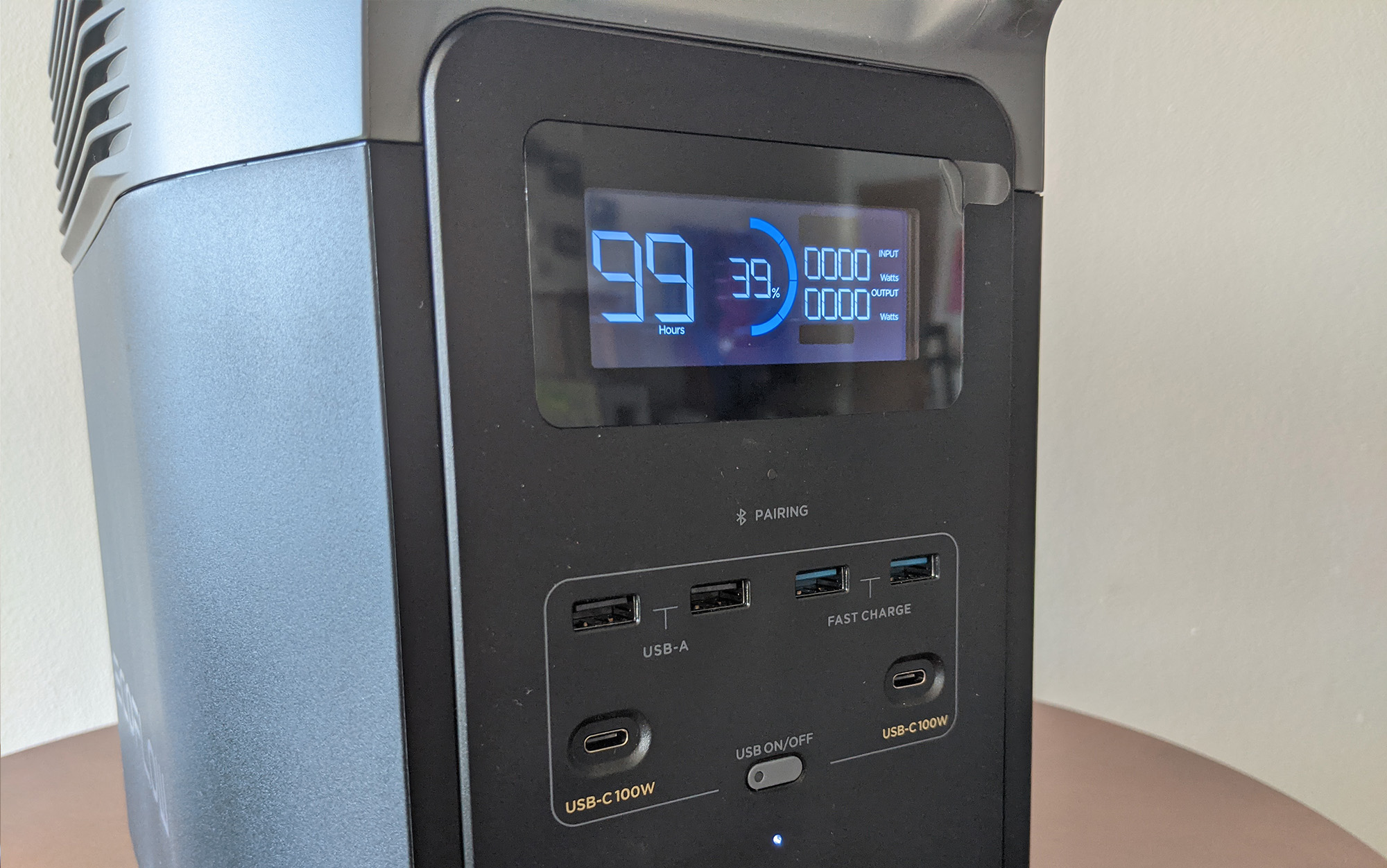
Laura Lancaster
Both the USB-C ports on the EcoFlow Delta 2 were capable of 100Ws of output, which is handy if you are using a newer USB-C cable for your laptop. I was also impressed with how little additional energy it lost out of the five unused AC ports. I wish the AC ports were on the same side of the unit as the USB ports and information panel, but there are certainly situations where it’s handy to have the cords configured at the back of the power station.
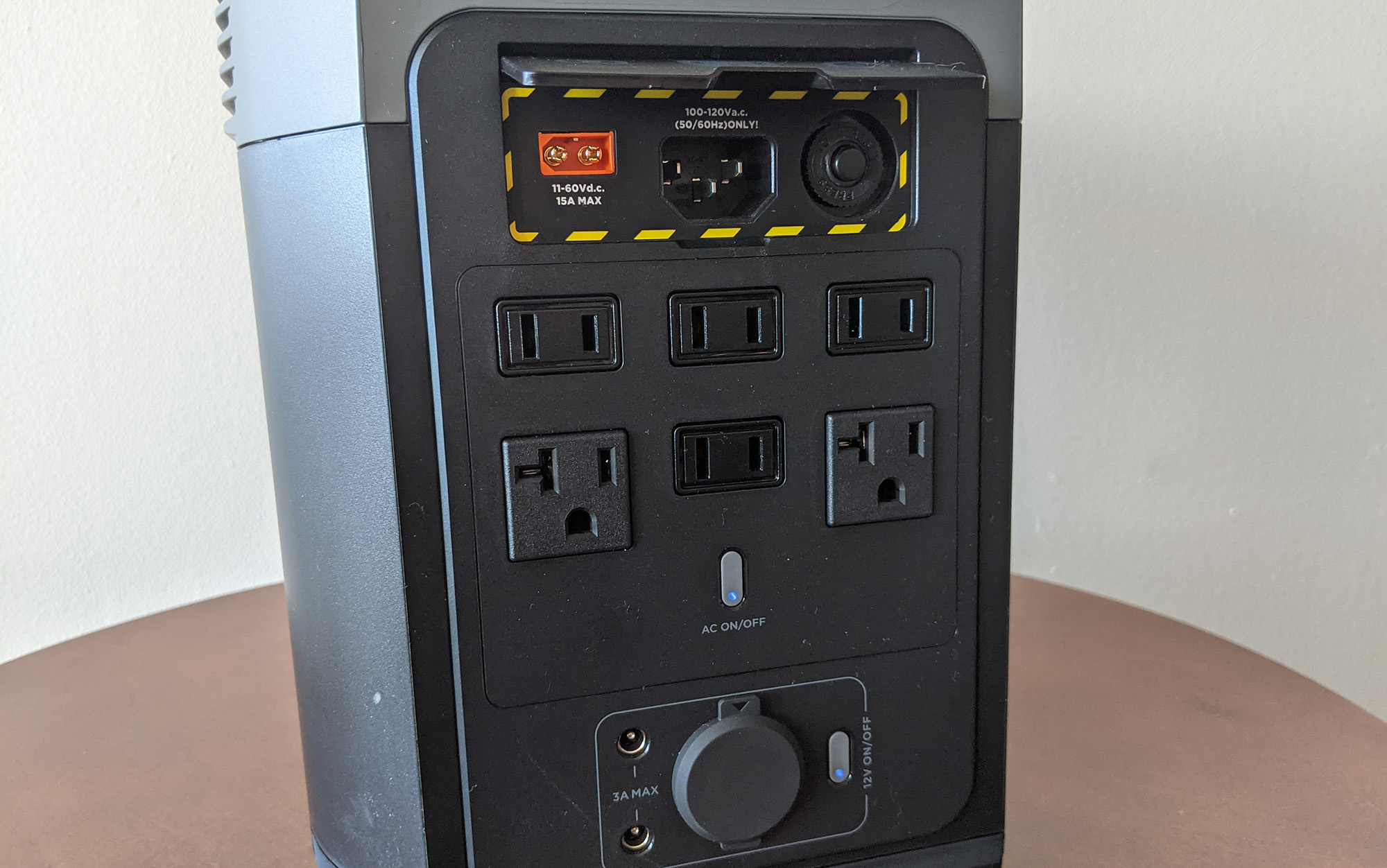
Laura Lancaster
The EcoFlow Delta 2 also stood out from the competition for its light weight (only the Ugreen PowerRoam was lighter at the same claimed wattage potential), and I found it easy to move around during testing.
Best for Solar Generators: Anker SOLIX C1000
Report Card
- Stated Watt Hours: 1056
- Provided 62% of stated watt hour potential at a consistent 34W draw
- Provided 90% of stated watt hour potential at a consistent 380W draw
- Recharge Time: 1.4 hours
- Confirmed Max Wattage: 1800 watts
- AC Port and Inverter Power Use: 25 watts
- IP Rating: None
Key Features
- Other Available Sizes: None in this series, but other Anker models come in different sizes
- Weight: 28.5 pounds
- Battery Chemistry: LiFePO4
- Manufacturer Claimed Lifecycles to 80 Percent Capacity: 3,000
- Warranty: 5 years
Pros
- Compact
- Best performance on the large power draw (dehumidifier) test
Cons
- Slightly longer recharge time than other models I looked at (option if you download their app to speed this up)
The Anker SOLIX C1000 was a very close second to the EcoFlow Delta 2. It had a higher percentage of energy efficiency against its stated watt hour potential in the large appliance test and had a more accurate display reading, staying on until it reached 1 percent stated capacity. However, it did worse than the EcoFlow in the most important test using the 34W grow light, suggesting it has a less efficient overall inverter than the EcoFlow. It also took slightly longer to charge. But it’s really close, and if the Anker SOLIX C1000 is a few dollars less expensive than the EcoFlow Delta 2 at the time you’re making your purchase, you should absolutely get it.
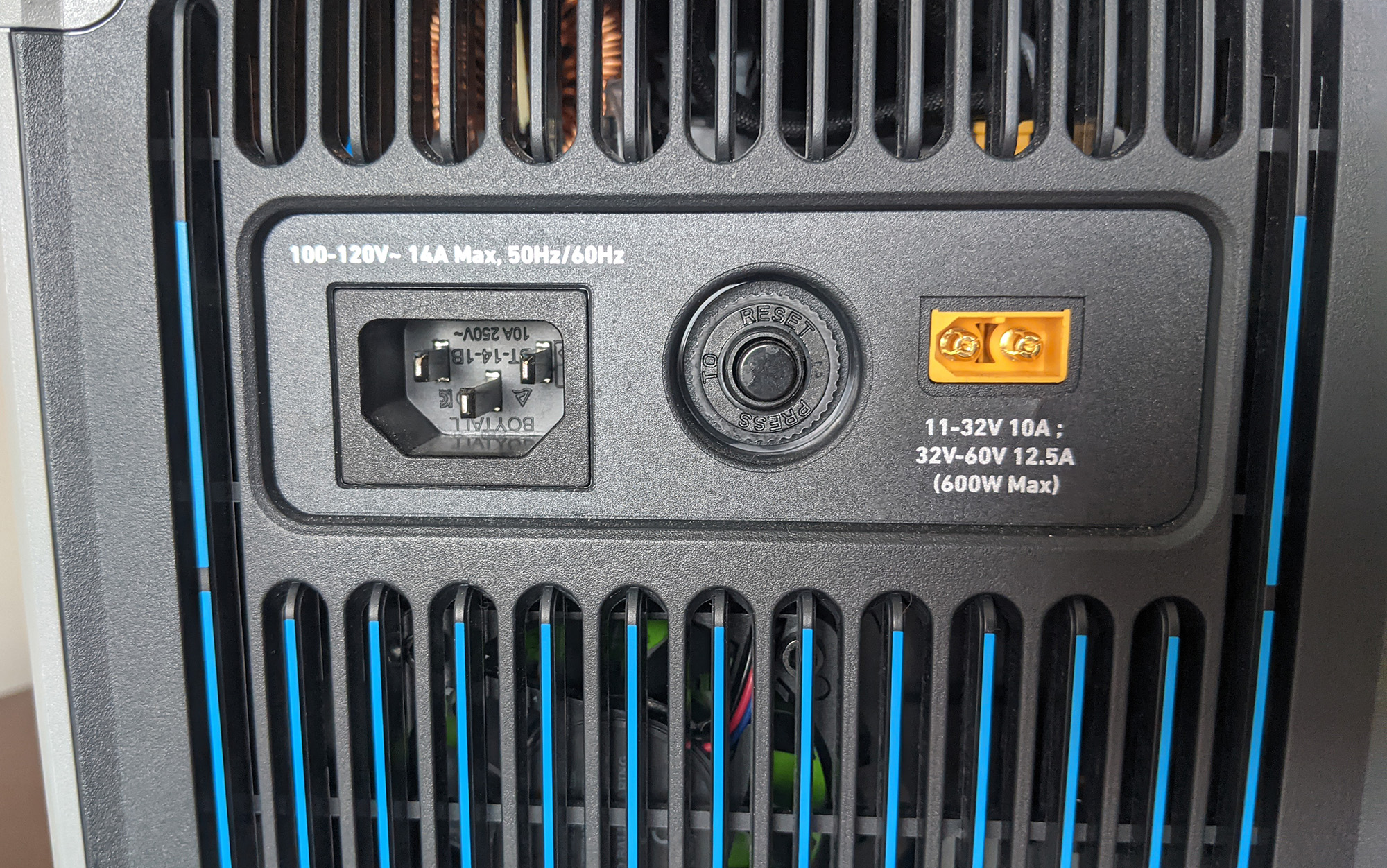
Laura Lancaster
You should also definitely choose the Anker SOLIX C1000 if you have any plans to convert your portable power station to a portable solar generator. In my testing of the best portable solar panels, I have been very impressed with the Anker panels, particularly their 100W panel, which includes a sundial to help you get the maximum energy potential in bright conditions. Conversely, I have been less impressed by the EcoFlow panels, which I have found tend to warp in storage after a few months.
Most Reliable: Goal Zero Yeti 700
Report Card
- Stated Watt Hours: 677
- Provided 70% of stated watt hour potential at a consistent 34W draw
- Provided 83% of stated watt hour potential at a consistent 380W draw
- Recharge Time: 1 hour, 58 minutes
- Confirmed Max Wattage: 600 watts
- AC Port and Inverter Power Use: 9 watts
- IP Rating: IPX4
Key Features
- Other Available Sizes: 297 watt hours, 499 watt hours
- Weight: 20.9 pounds
- Battery Chemistry: LiFePo4
- Manufacturer Claimed Lifecycles to 80 Percent Capacity: 4,000
- Warranty: 5 years
Pros
- The most efficient unit tested for the grow light test
- Accurate control panel readings
- One of the few power stations to display the loss of power through the AC ports
Cons
- Somewhat less intuitive to use than other power stations I looked at
- The model I tested is not available in larger sizes (although other Goal Zero power stations are much, much larger)
The Goal Zero Yeti 700 was one of the most impressive units during testing. It achieved 70 percent efficiency against its stated 677Wh size and powered a 34W grow light for over 13 hours. While the Lion Energy Summit just squeaked by with the most efficient overall time, it was still showing 8 percent power left in the unit when it suddenly shut off.
Compare that to the Goal Zero Yeti 700, which lasted for a surprisingly long time even when the display still had it clocked at 1 percent. Unlike other units I tested, the Goal Zero Yeti 700 also shows the power being used by the power station. To me, this is the right way to handle this: Users are more likely to wonder how much energy the power station is using to power a particular appliance, than wonder how much energy the appliance itself is using. It also serves as a reminder to turn the AC outlets off when they aren’t in use, as they represent a fairly significant drain on the battery.
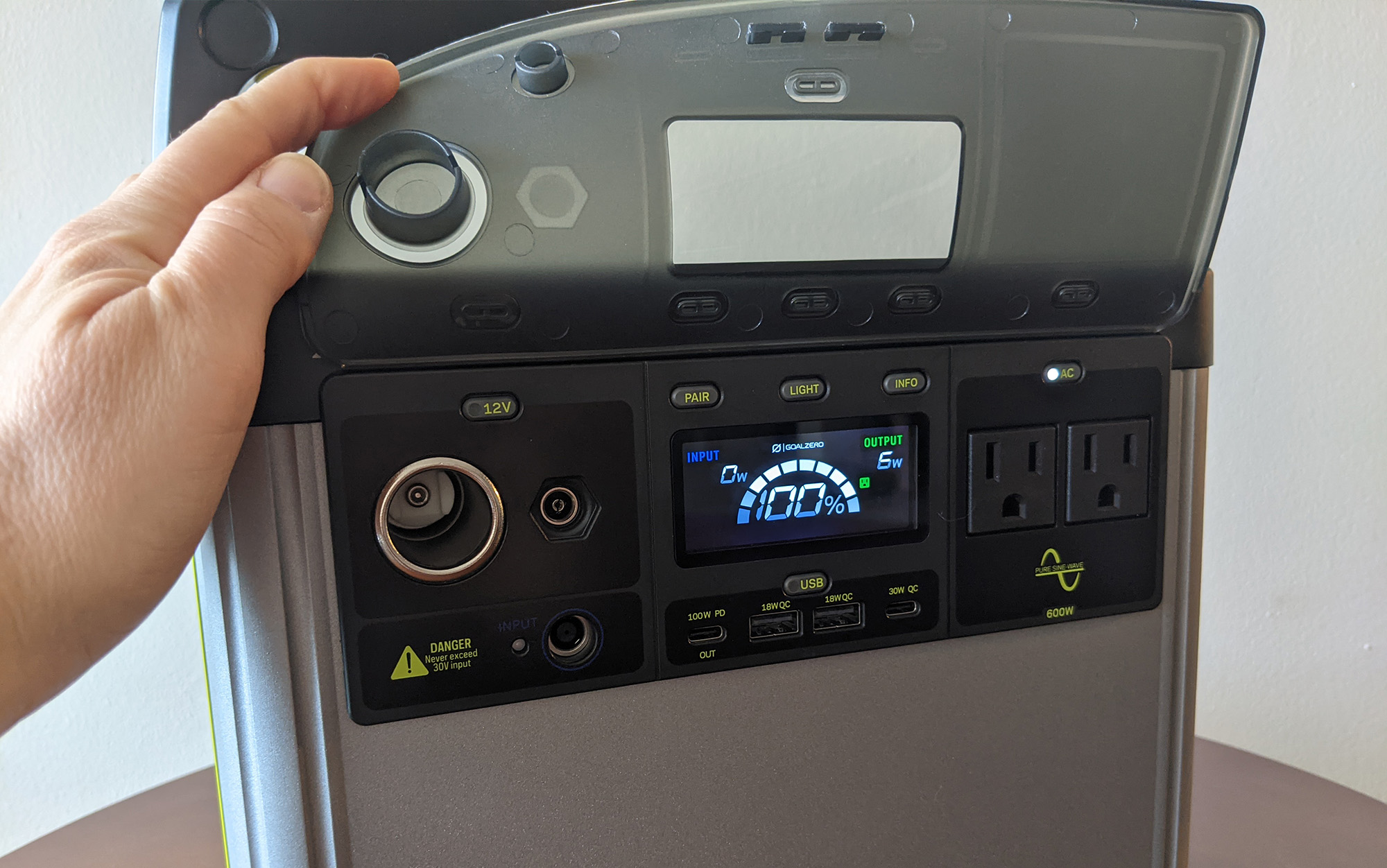
Laura Lancaster
In terms of portability, I liked the fold down handle of the Yeti 700. It was comfortable to carry, in large part because of its comparatively small size. Its shorter height compared to the other units I looked at means it could be easily tucked onto a shelf in an already crowded closet for long-term storage.
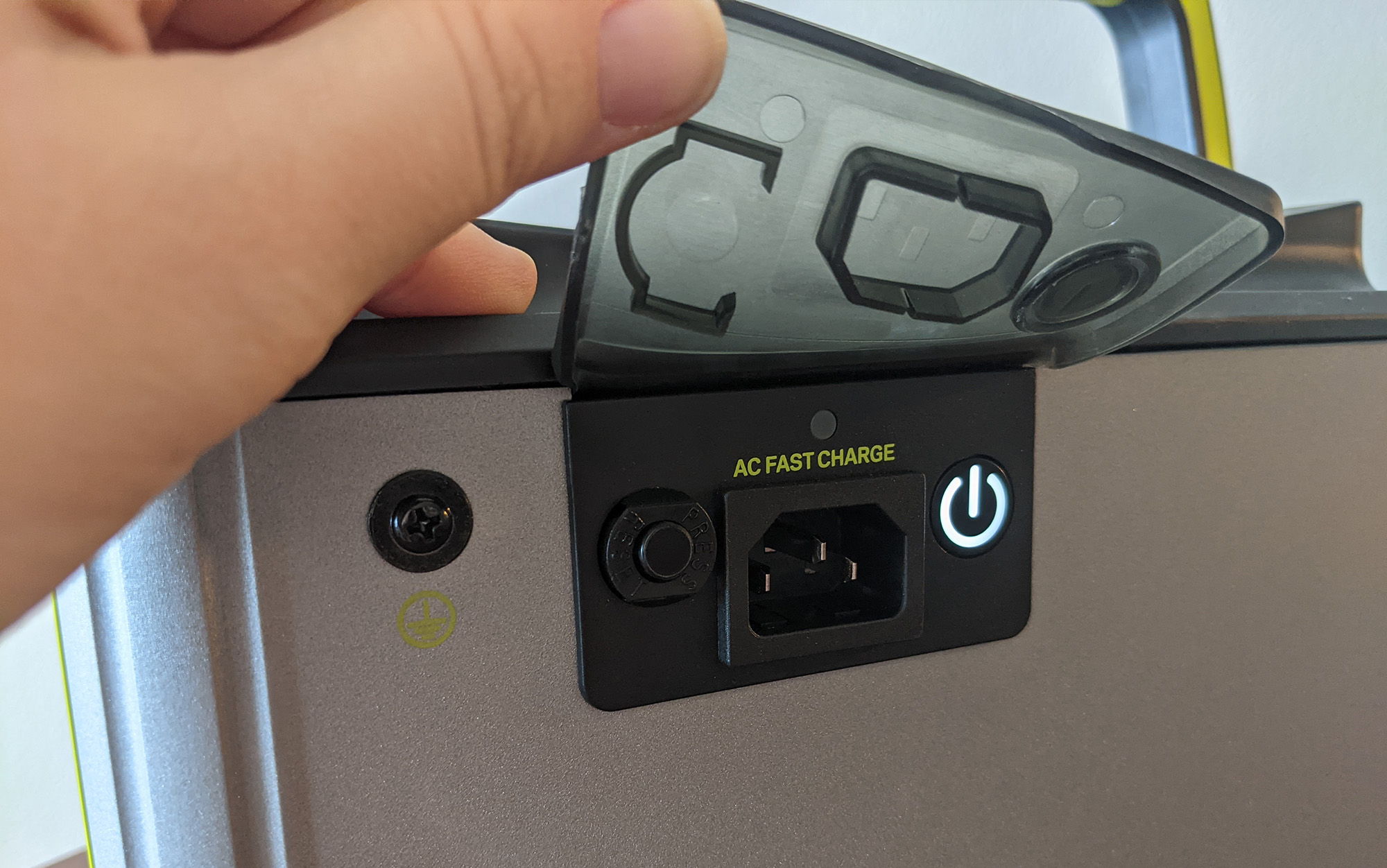
Laura Lancaster
My only gripe with this otherwise excellent unit is that it is a little less intuitive to use than the others. For instance, the power button is on the back of the unit, by the charging input port, rather than on the front. The silicone also has to be pulled back every time you use the Yeti 700. But these are small complaints against what is otherwise an excellent power station.
Best for High-Watt Appliances: Bluetti AC180
Report Card
- Stated Watt Hours: 1152
- Provided 39.9% of stated watt hour potential at a consistent 34W draw
- Provided 85% of stated watt hour potential at a consistent 380W draw
- Recharge Time: 1 hour, 20 minutes
- Confirmed Max Wattage: 1800 watts
- AC Port and Inverter Power Use: 14 watts
- IP Rating: None
Key Features
- Other Available Sizes: A variety of sizes from 204 watt hours to 2048 watt hours
- Weight: 37 pounds
- Battery Chemistry: LiFePo4
- Manufacturer Claimed Lifecycles to 80 Percent Capacity: 3,500
- Warranty: 5 years
Pros
- Only unit I tested with wireless charging
- Compatible with Bluetti’s excellent solar panels
- Available in a wide variety of sizes
Cons
- Low efficiency compared to other units in my test
- Heavy
I’ve had great experiences with other Bluetti products — their solar panels are some of my top picks for camping — so I was excited to see how much juice was inside of one of their best-in-class portable power stations. Unfortunately, testing showed that it performed worse (about 47 percent efficiency) than similar options from Anker and EcoFlow in the low wattage test. It also weighed significantly more. For most people in the market for a portable power station to keep their laptop or CPAP machine going during a blackout, this isn’t the right choice.
However, there was one test where the Bluetti AC180 beat the competition: the high-wattage appliance test. While it didn’t have the highest efficiency against its stated watt hour capacity, it did provide the most value for its price point. If you are looking for a short-term backup power source for something energy intensive, like an air conditioning unit, this would be an excellent option. It was also the only portable power station I looked at that had a wireless charging option.
Most Efficient: Lion Energy Summit
Report Card
- Stated Watt Hours: 665
- Provided 72% of stated watt hour potential at a consistent 34W draw
- Provided 86% of stated watt hour potential at a consistent 380W draw
- Recharge Time: 4 hours, 48 minutes
- Confirmed Max Wattage: 530 watts
- AC Port and Inverter Power Use: 13 watts
- IP Rating: None
Key Features
- Other Available Sizes: 1612 watt hours
- Weight: 18 pounds
- Battery Chemistry: LiFePO4
- Manufacturer Claimed Lifecycles to 80 Percent Capacity: 3,500
- Warranty: 5 years
Pros
- Most efficient unit I tested
- Very portable
Cons
- Long charging time
- Low max wattage
- Display is not as accurate as I would have liked
At 72 percent during the grow-light test, the Lion Energy Summit was the most efficient unit I tested. And while not as small and compact as the Goal Zero Yeti 700, it was still on the petite side, with a nice carrying handle that flexed comfortably when I picked it up.
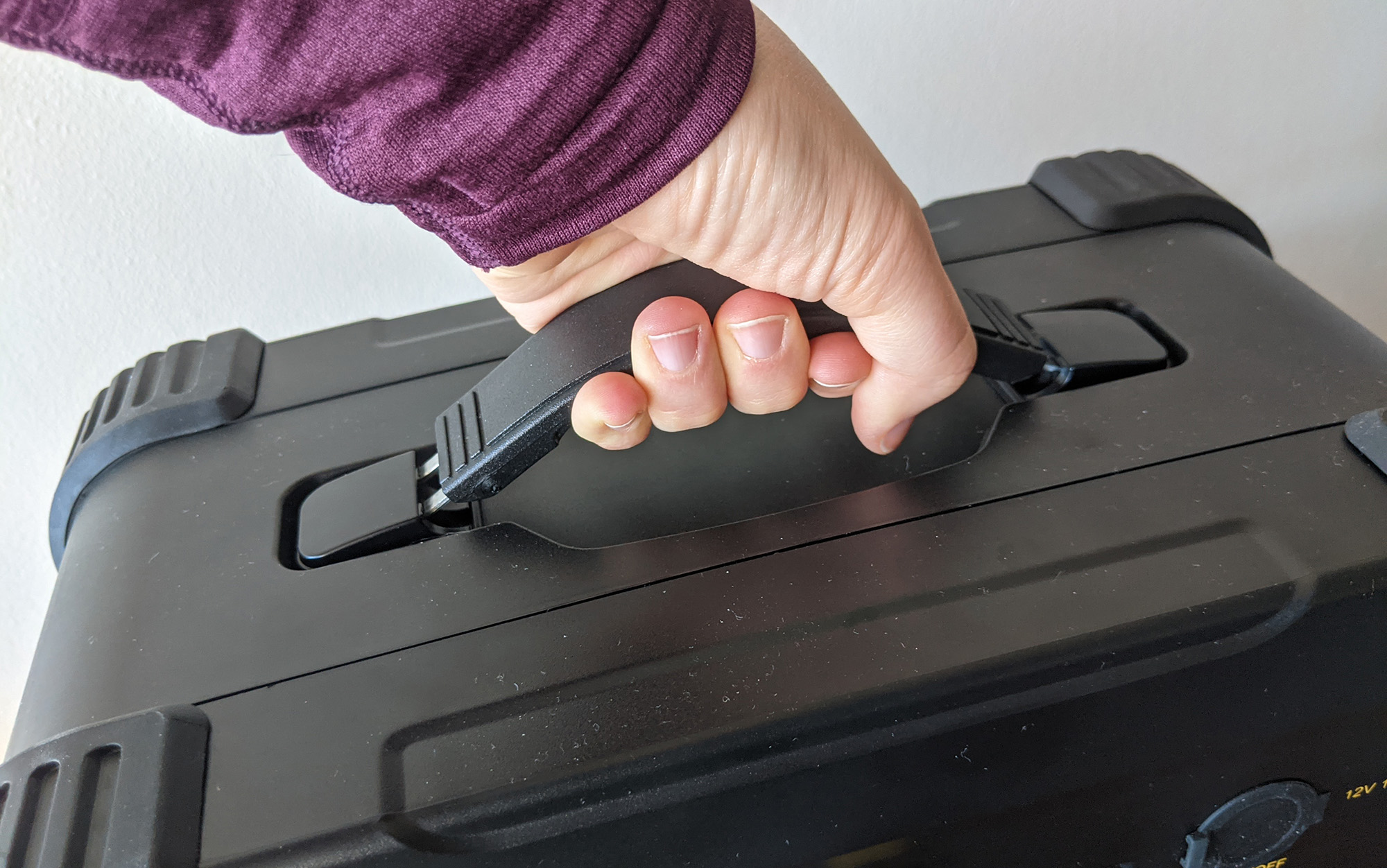
Laura Lancaster
Unlike the Goal Zero Yeti 700, the display panel for the Lion Energy Summit was not as accurate as I would have liked. It showed 8 percent at my last check of the 34-watt grow light, but then switched off just a few minutes later. If you’re trying to estimate if you have enough juice to run the coffee maker and get your phone charged up before hitting the road, err on the side of caution.
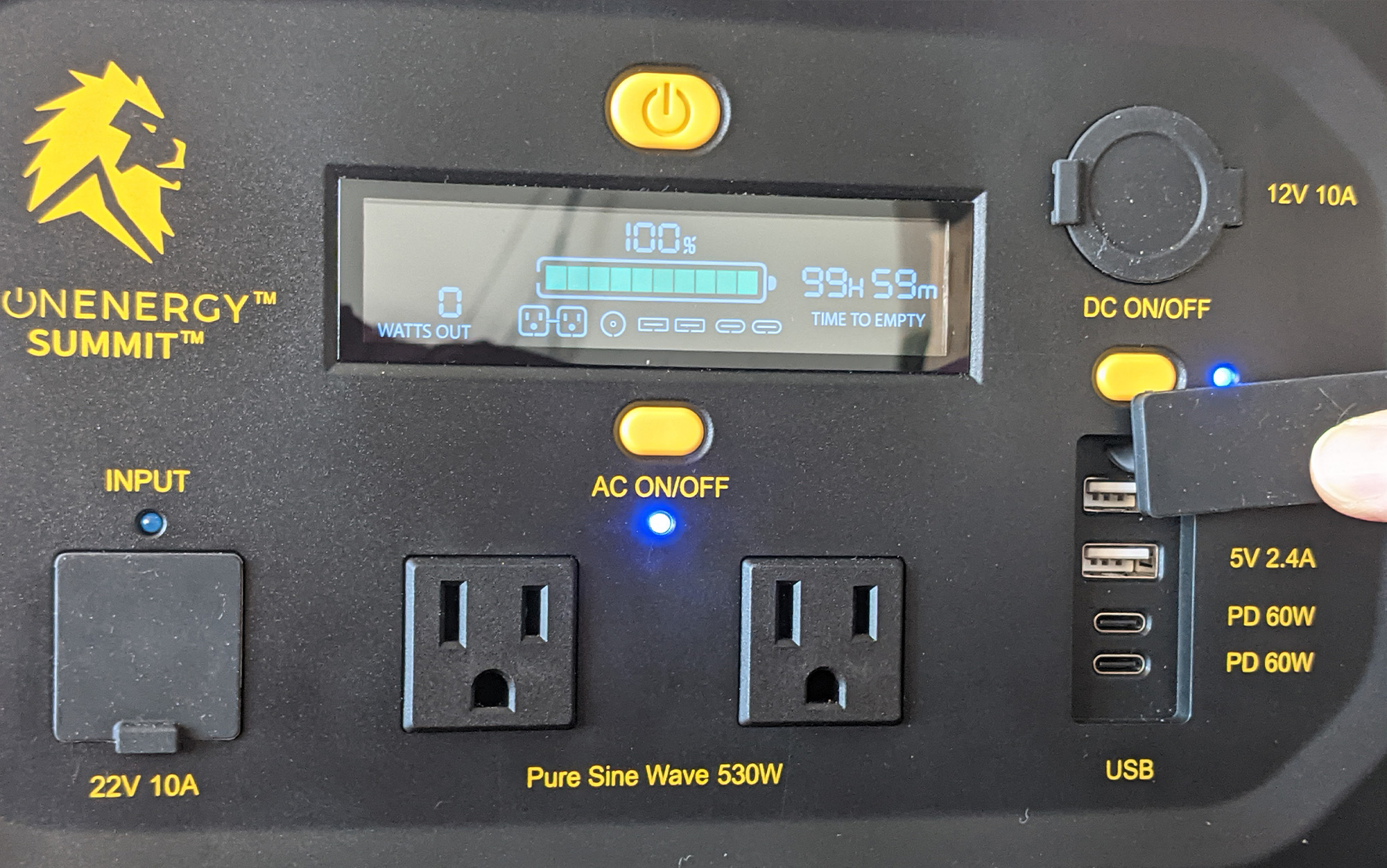
Laura Lancaster
The Lion Energy Summit also stood out for having one of the slowest charging times in my test: over four hours. While I generally think that the difference between an hour and two hours to fully charge a power station is a non-issue, forgetting to charge up this power station in advance of your big weekend could make for a serious delay.
Easiest to Use: Jackery Explorer 1000 Plus
Report Card
- Stated Watt Hours: 1265
- Provided 49% of stated watt hour potential at a consistent 34W draw
- Provided 86% of stated watt hour potential at a consistent 380W draw
- Recharge Time: 1.8 hours
- Confirmed Max Wattage: 2000 watts
- AC Port and Inverter Power Use: Unavailable
- IP Rating: None
Key Features
- Other Available Sizes: 288 watt hours, 2043 watt hours
- Weight: 32 pounds
- Battery Chemistry: LiFePO4
- Manufacturer Claimed Lifecycles to 80 Percent Capacity: 4,000
- Warranty: 5 years
Pros
- Easy to use
- Efficient energy use
Cons
- Slightly longer recharge time than other models I looked at
- On the heavier side
- Expensive
- Some durability concerns
Jackery’s power stations have always stood out to me as being exceptionally easy to use, sort of like the iPhone of portable power stations. Their display panel is straightforward and intuitive, their bright-orange charging cables are color-coded to the power station itself. Anker and EcoFlow also do a great job in this area, but not quite at the level of Jackery. But, like the iPhone, it all comes at a cost. First off, this power station was pricier than its competitors, although that is difficult to quantify given the the number of sales there are for this category. It’s also heavier and bulkier. While I could comfortably lift the Goal Zero and Anker power stations, the Jackery power station was more of a chore to lug around.
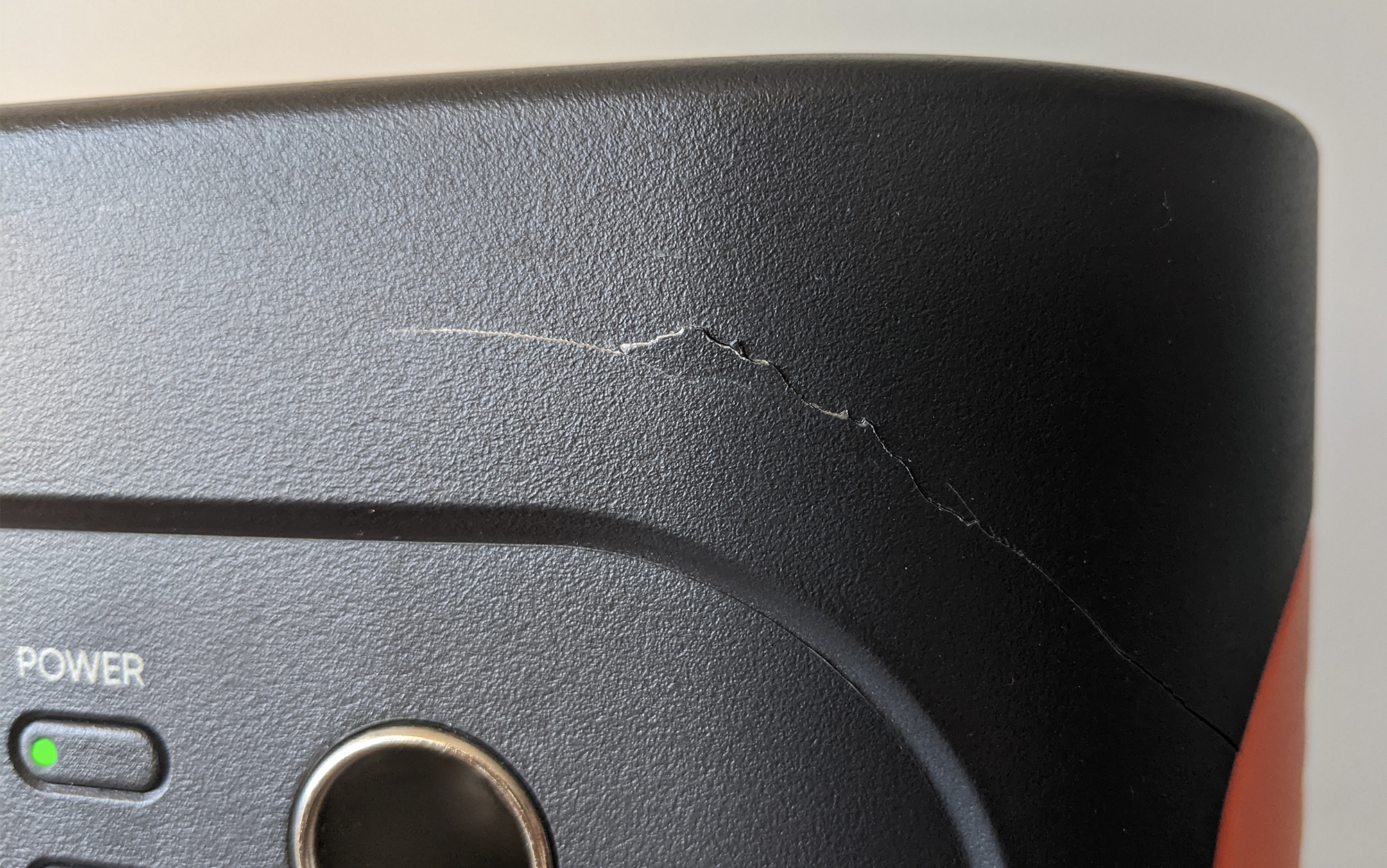
Unfortunately, during testing it didn’t quite match the performance of other power stations. On the grow light test, in particular, it came in at 49 percent of its stated capacity, fully draining in less time than units with less capacity. It fared better on the dehumidifier test, fortunately. Of more concern, somewhere in my testing, this unit picked up some cracks in the housing. I did not include a durability test in my protocol; this was something that happened in the course of moving the power station around for testing. It’s disappointing and the first time I have had this happen in my testing of dozens of power stations. I hope that Jackery looks at improving the durability of the housing in the future.
Dakota Lithium PowerBox + 60 Waterproof Power Station
Report Card
- Stated Watt Hours: 720
- Provided 64% of stated watt hour potential at a consistent 34W draw
- Unable to test the 380W draw appliance due to the design of the inverter
- Recharge Time: 6+ hours
- Confirmed Max Wattage: 300 watts
- AC Port and Inverter Power Use: 2.4W
- IP Rating: IP67
Key Features
- Other Available Sizes: None
- Weight: 27 pounds
- Battery Chemistry: LiFePo4
- Manufacturer Claimed Lifecycles to 80 Percent Capacity: 200 watts
- Warranty: 11 years
Pros
- Can be used to jumpstart a boat or a car
- Highest waterproof and dust-proof rating that I looked at
- Cords store inside the case
- Long lasting warranty
Cons
- Much less intuitive to use than other options in my test
- Onboard computer is unreliable and doesn’t provide sufficient information
- Complicated charging
- Heavy
Most portable power stations aren’t really designed to be used in any kind of weather or inclement conditions. Their ports are exposed, they’re heavy to lug around. There were a few exceptions to this in my testing, particularly the Dakota Lithium PowerBox. This unit has a rating of IP67, which is beyond impressive for a portable power station.
Ingress Protection (IP) Testing is conducted by a third party to evaluate how well a product protects against dust and water. The first digit represents its dustproof rating, and the second digit represents its waterproof rating. In this instance, the “6” in the Dakota Lithium Powerbox’s rating is the highest available rating, representing complete protection against dust. The “7” represents the ability to withstand submersion in up to 1 meter of water for 30 minutes. According to Dakota Lithium, the “up to 1 meter” is a bit superfluous anyway, as this unit will float in the water.
While I did not test this feature out (I draw the line in my testing at tossing a lithium battery into a body of water), the interior of the PowerBox shows a fair amount of open space and foam, lending plenty of credence to this idea that it will float.
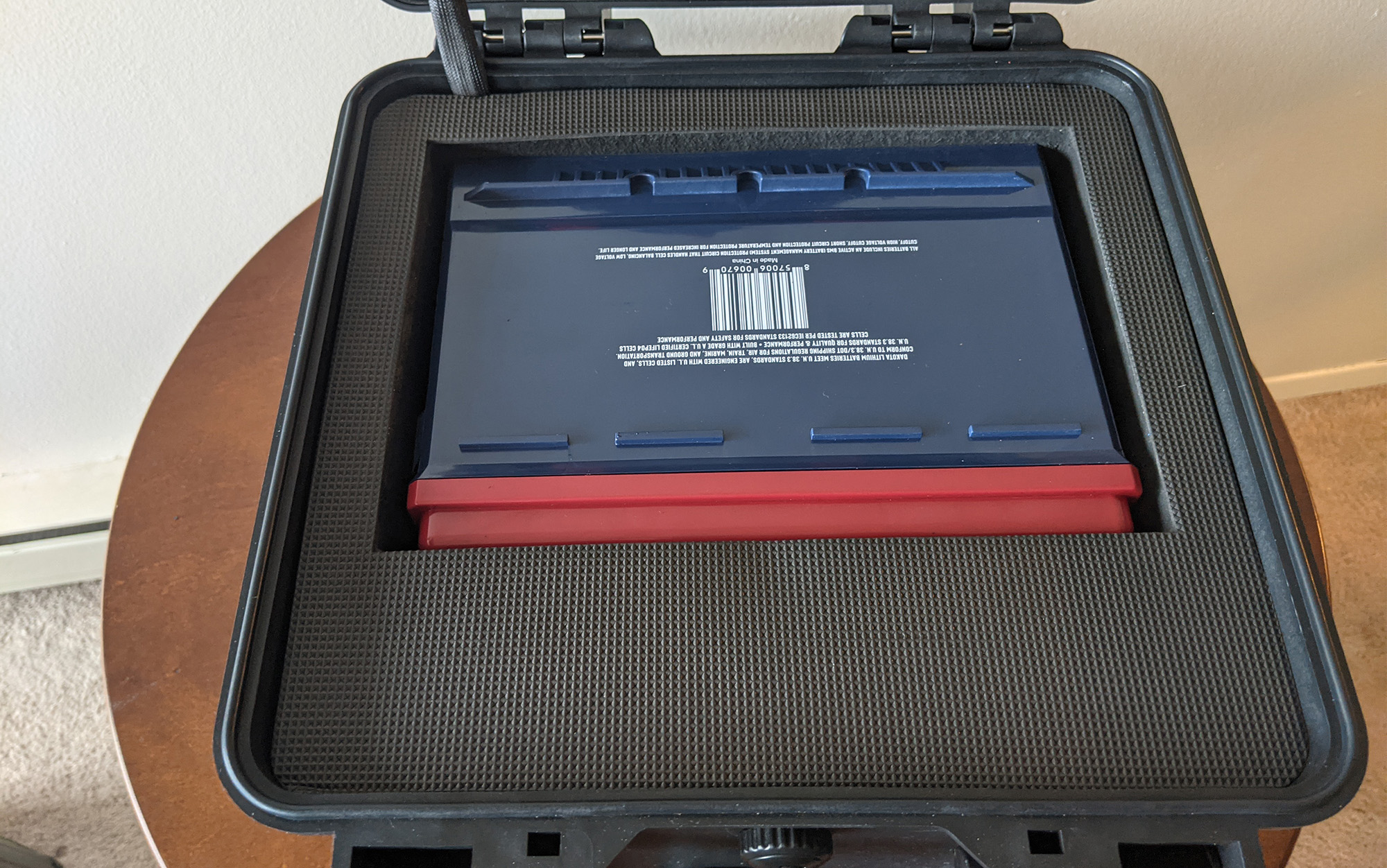
Laura Lancaster
Impressed as I was by the Dakota Lithium PowerBox’s weather protection bonafides, it’s not clear to me what its function would be. Most boats will already have on-board batteries while the vast majority of river setups (such as whitewater rafts or kayaks) typically would stash one of the best power banks for camping inside of one of the best dry bags. I was also disappointed by a few of its features including its available ports. While this unit has 4 USB-A ports, it has no USB-C.

Laura Lancaster
While it does have two AC outlets, I found that they were not very easy to access, such that I was not able to plug in the cord for my dehumidifier at all. If the socket for your AC cord is on the larger side, you’re going to struggle to plug it in. I also wasn’t a huge fan of the charging mechanism for this unit, as it was both exposed and complicated.
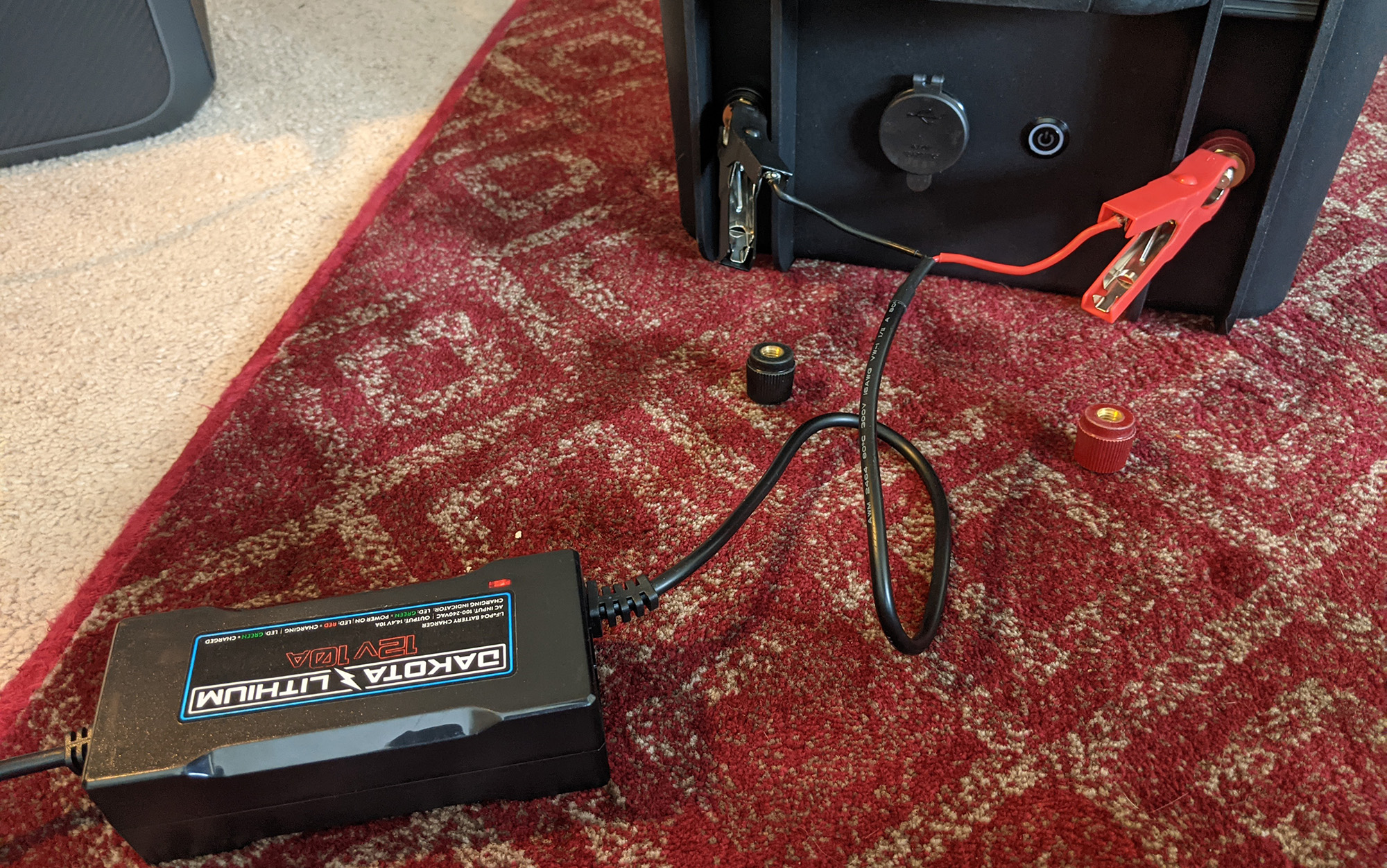
Laura Lancaster
During testing, I noted that the display on the inverter showing the amount of energy left was inconsistent. For over half of testing there was no drop at all in the amount of energy left that was shown, but it went down from two to zero bars in only a couple of hours. While this is in part due to the difficulty of getting a truly accurate reading out of a lithium battery (there were minor inconsistencies in the rate of drop across all of the portable power stations I looked at), this one stood out as being especially unreliable.I also struggled with figuring out when this unit was fully charged. I left it plugged for hours with the inverter showing a full charge but the power cord still showing red (it’s meant to turn green when fully charged).
Vtoman FlashSpeed 1500
Report Card
- Stated Watt Hours: 1548
- Provided 50% of stated watt hour potential at a consistent 34W draw
- Provided 78% of stated watt hour potential at a consistent 380W draw
- Recharge Time: 1 hour, 1 minute
- Confirmed Max Wattage: 1500 watts
- AC Port and Inverter Power Use: 4 watts
- IP Rating: IP63
Key Features
- Other Available Sizes: None
- Weight: 41.5 pounds
- Battery Chemistry: LiFePo4
- Manufacturer Claimed Lifecycles to 80 Percent Capacity: 3,100
- Warranty: 5 years
Pros
- Very fast recharge time
- Convenient lid on top for storing cables (if a bit small)
Cons
- Low efficiency compared to other units I looked at
- Overall construction is not terribly sturdy
The Vtoman FlashSpeed 1500 did indeed charge very quickly. Despite being the largest portable power station I looked at, it took just over an hour to completely charge, faster than anything else I tested. If you need to charge up and move a power station to a different location multiple times a day, this is an option worth looking at.
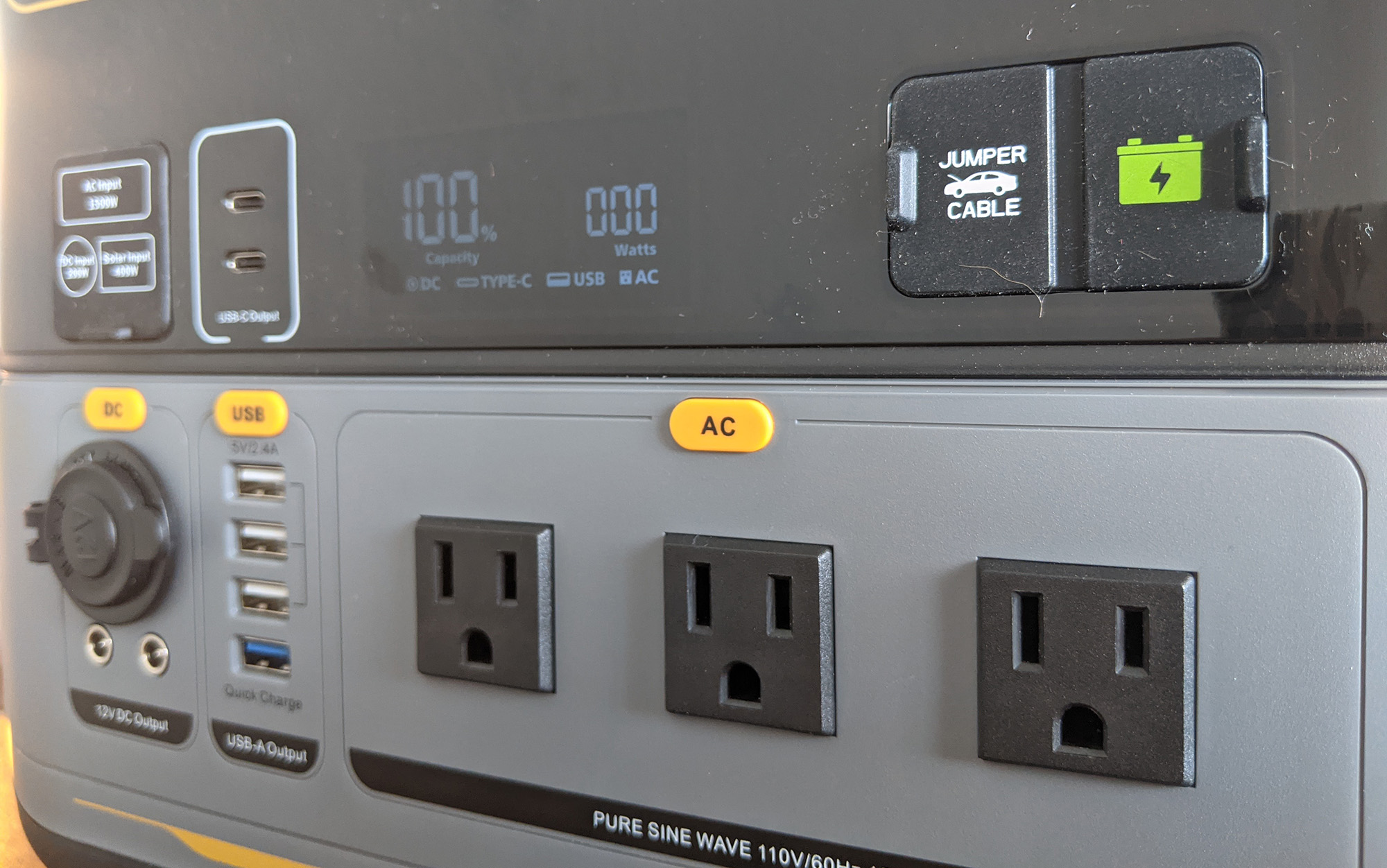
Laura Lancaster
Unfortunately, it had low efficiency compared to other units I looked at, using just under 50 percent of its available energy to power my grow light before tapping. I was also surprised to see a portion of one of the side panels starting to detach after fairly minimal use.
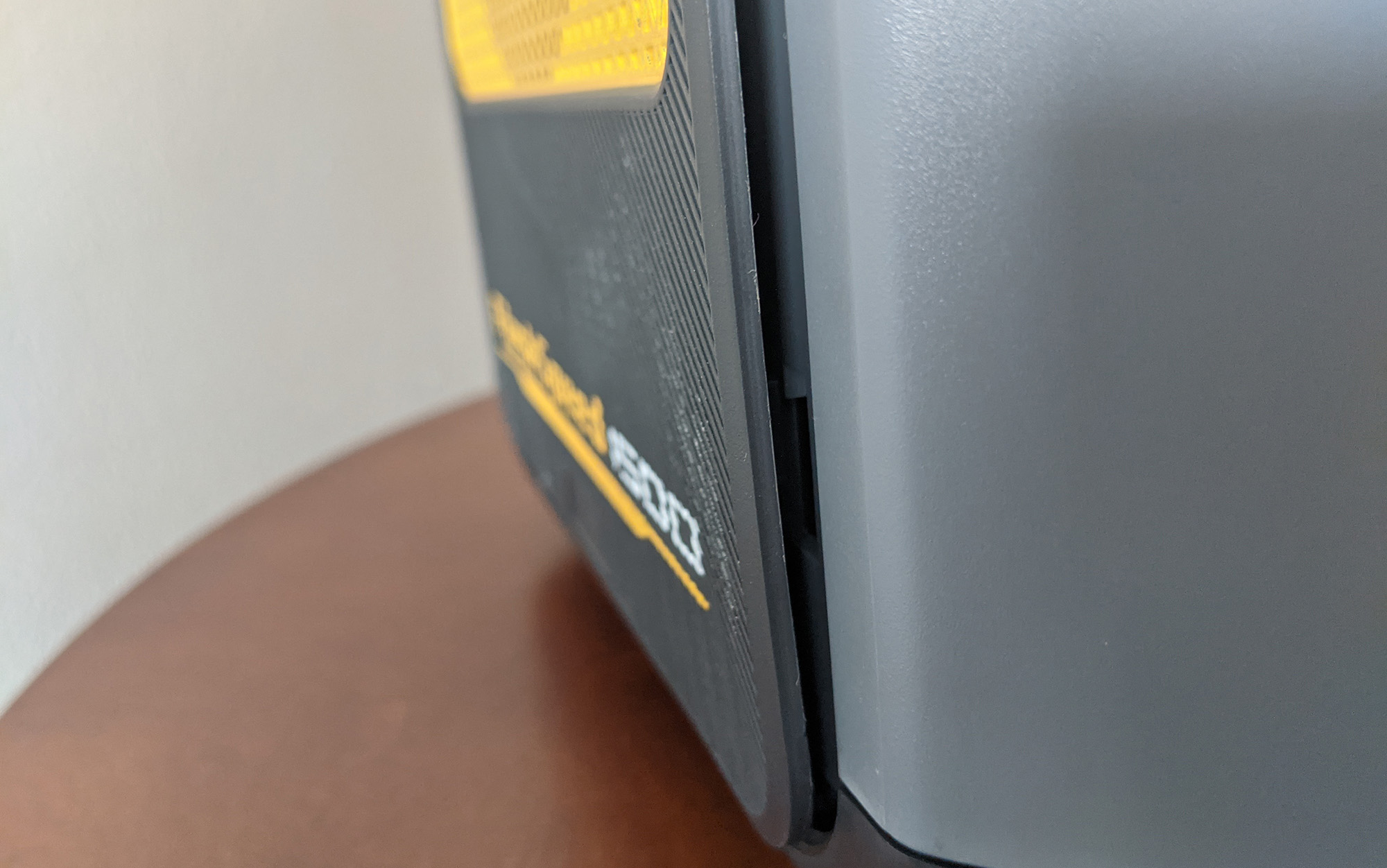
Laura Lancaster
That being said, there were some details I appreciated. It had a convenient top storage compartment for cables (although strangely it did not fit all of the provided cables).
Ugreen PowerRoam
Report Card
- Stated Watt Hours: 1024
- Provided 67% of stated watt hour potential at a consistent 34W draw
- Provided 85% of stated watt hour potential at a consistent 380W draw
- Recharge Time: 1 hour, 5 minutes
- Confirmed Max Wattage: 1200 watts
- AC Port and Inverter Power Use: 30 watts
- IP Rating: None
Key Features
- Other Available Sizes: 2048 watt hours
- Weight: 25.4 pounds
- Battery Chemistry: LiFePo4
- Manufacturer Claimed Lifecycles to 80 Percent Capacity: 3,000
- Warranty: 5 years
Pros
- Fast recharge time
- Efficient for larger wattage appliances
Cons
- Stricter warranty than others on this list, particularly if you fail to charge the battery for a longer period of time
The Ugreen PowerRoam ticks all the boxes. It has the same standard battery chemistry as the other power stations in my test, similar price point and build. It was one of the faster units to recharge and it had excellent efficiency during the high-wattage test with the dehumidifier. And despite reporting a higher wattage use for the AC port (20 to 30W), it did fine during both the low-wattage and the high-wattage tests.
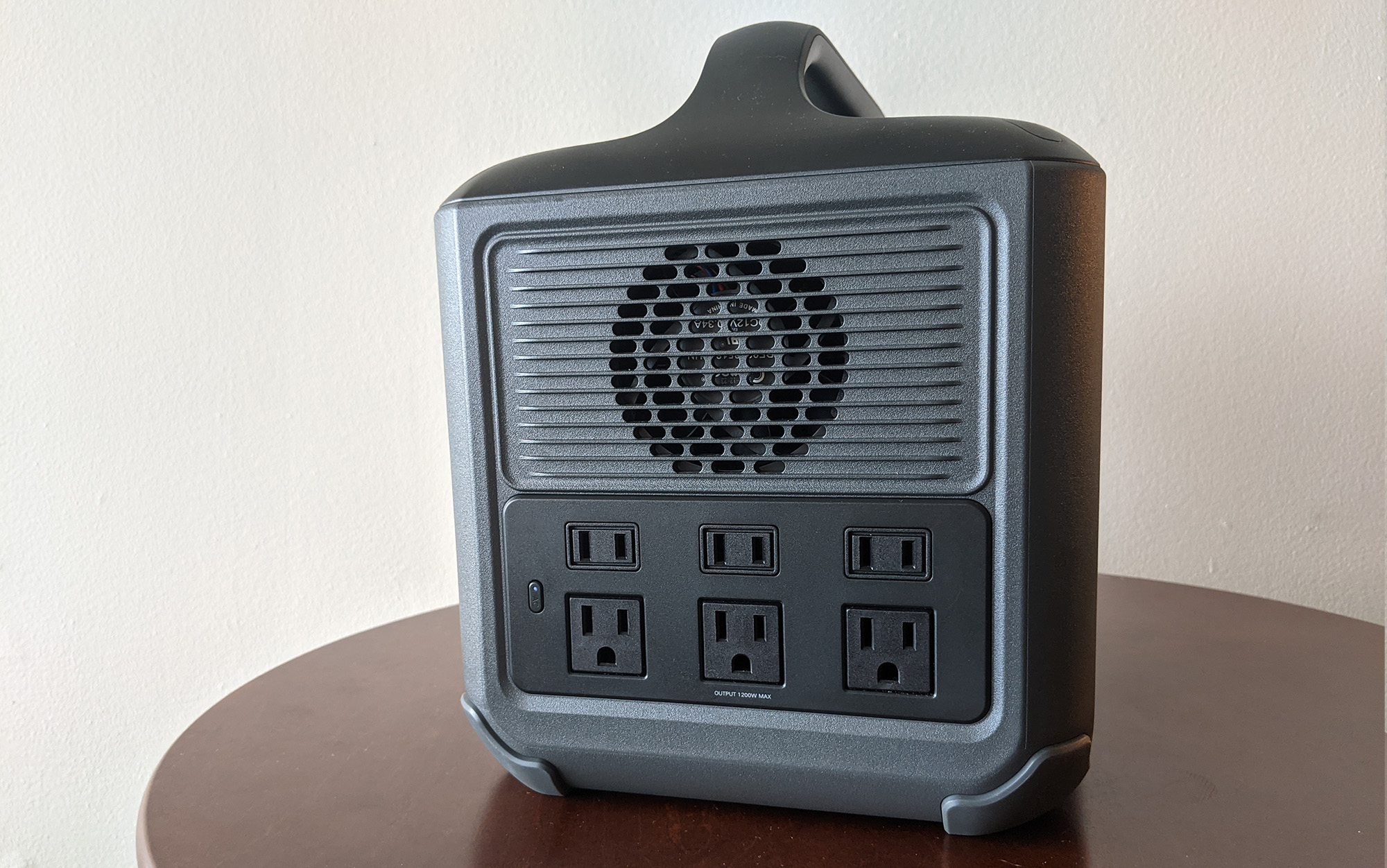
Laura Lancaster
In conversations with the manufacturer, I was also surprised to learn that they would consider leaving the unit at 20 percent or less capacity for an extended period of time to be improper use (this came up when I was querying about what would void the warranty). In my experience, that’s an unusual recommendation. Unless you find this one on an exceptionally good sale, I’d opt for one of the other options on this list.
What to Know Before Purchasing a Portable Power Station
Watt Hours
Whatever the reason you are purchasing a power station, the most important spec to pay attention to is watt hours, which is a measurement of how much energy the power station can hold. While a particular power station might claim to hold 1,000 watt hours, the actual amount of usable power you can get out of it is a different story. The best portable power stations also have an onboard computer that shows you how much energy is left in your unit, as well as how much power it’s currently using.
If this is your first time purchasing a unit, you are probably wondering how much power a portable power station should have? The answer to this depends largely on what you intended to do with it. If all you want is backup power for your family’s phones while camping over the weekend, you can get away with something relatively small — 200 watt hours would be more than enough. But if you’re looking for emergency backup to power your air conditioning unit (which use, conservatively, 1000Wh in an hour) during rolling blackouts in the summer months, you’ll need something substantially larger.
To help find a simpler answer to the question of what size portable power station, I spoke to Ben Pattison, Director of Product Development at Goal Zero. He recommends looking at what systems or devices you plan on using, and for how long. For some people it could be their refrigerator and their space heater. For others, it could be a TV or other entertainment system.
If you want to run your refrigerator for a day (uses 67 watts per hour) and fully charge your laptop once per day (typically 51Wh), you’d need a power station that could handle at least 1,659 watt-hour capacity. You’ll also need to see what the maximum draw is for each of your electronics. While a refrigerator may use an average of 67 watts per hour, it doesn’t use that energy evenly: sometimes it will use 6 watts, sometimes it will surge and need 800 watts. Typically you can determine this number by multiplying the watt requirements by six (to guesstimate the needs), or by multiplying the amps and volts ratings together.
Here is a rough estimate of the power needs of a few common appliances — the particulars may vary:
- Laptop: 60Wh to fully charge
- Cellphone: 5Wh to fully charge
- Coffee maker: 200Wh per pot
- Space heater: 1500Wh per hour
- Box fan: 75Wh per hour
- Refrigerator: 1500Wh per day
- Freezer: 4000Wh per day
- Air conditioner: 1500Wh per hour
- Clothes washer: 250Wh per load
- Clothes dryer: 2000Wh per load
If all you have is a basic wattage number, say for a light bulb, typically that can serve as the watt hour number. For instance, if you are trying to power a 40-watt light bulb for one hour, it will use 40 watt hours. When choosing the right portable power station size for your needs, tack about 30 percent on to account for power loss while in use.
The power station size you need will in large part depend on what your definition of “critical” is, with some individuals content to rough it as long as they can keep their phone charged and the space heater running while others may want something more substantial. For the former group, a best-in-class power station often suffices, as you can simply pick it up and move it to whichever room you currently need power in. But if you plan to power a larger chunk of your home, that quickly leads to a mess of power stations and extension cords. Instead look at some of the new (non-portable) generators coming out from the likes of Goal Zero and Anker.
Battery Chemistry
Today’s best-in-class portable power stations are much more than a jumped up version of a classic rechargeable lithium battery. A lot of research has gone into figuring out how to build batteries that are powerful yet compact and lightweight, long-lasting and also stable and safe. The two main classes of batteries you’ll see right now in portable power stations are LiFePO4 and NCM. LiFePO4 batteries utilize lithium, iron, and phosphate, and are considered safer and longer lasting than other batteries. They are, comparatively, lower in price for the power they deliver. NCM batteries utilize lithium nickel manganese cobalt oxides and are typically lower in weight for the same energy potential (described as energy density). This makes NCM the more common battery chemistry for electric cars and other devices where weight is a priority (like smartphones).
All of the power stations in this test utilized LiFePO4 and I would recommend that you seek out this battery chemistry when making a purchase. There are significant human rights issues around the cobalt used in NCM batteries, due in large part to the bulk of the global supply of cobalt coming from the Democratic Republic of Congo (DRC). Despite the vast demand for cobalt, much of the population of the DRC lives in extreme poverty, and men, women, and children often resort to harvesting cobalt with minimal to no tools in extremely dangerous conditions. The increase in demand as a result of the need for cobalt to power many of the electronics in modern life has only exacerbated the situation.
There has also been concern that the heavy concentration of cobalt in the DRC, where 80 percent of the output is owned by China, represents a national security threat to the United States. As a result, there has been considerable investment in research to move away from certain rare-earth metals in battery chemistry, including for electric cars. The good news for anyone in the market for a portable power station is that the industry as a whole is moving toward LiFePO4 batteries.
Energy Potential
One of the most important factors in choosing a portable power station is the amount of energy it can store, known as its energy potential. The energy potential of a battery depends on a number of factors, including battery chemistry, size, and age. Manufacturers will express the amount of energy that a battery can hold in watt hours.
For instance a 100 watt hour power station holds enough power for an electronic that uses 10 watts for 10 hours. Or for an electronic that uses 100 watts for one hour. However, keep in mind that the power station itself is using a fair chunk of that power to actually work. My testing above shows how much power you can expect to get out of different power stations in two different scenarios. Check this specification for the portable power station you are considering and compare it to your energy needs before making a final decision.
Warranty
With proper care, today’s portable power stations can last as long as a decade or more. But, from my experience with testing the best solar generators, there are a couple of things that can go sideways. The most common issue for campers will be draining the battery over the course of a long weekend, and then forgetting to charge it. If you’re thinking of purchasing a portable power station for home backup, you can also run into issues with the power station draining, and eventually emptying, over time. Draining a battery and then failing to recharge it will eventually damage the battery.
Less Critical Considerations
Weight
Generally speaking, power stations with more watt hours and more voltage potential will be heavier. If portability is a key consideration for you, aim for a smaller unit rather than a larger one.
Recharge Time
Increasingly power stations are advertising lightening fast recharge times. While I did test this capability to see if it lined up with manufacturer specifications, I think it should be low on your priority list when you are choosing a portable power station. There are very few instances where a recharge time of one hour versus two hours is going to matter all that much. Focus instead on actual watt hour potential and price.
Unit Power Loss
Portable power stations leak energy over time. If you plan to use your power station primarily for overlanding or camping this is not an important issue: just top it off before you head out the door. However, if you plan to power up your power station and then stash it in the garage until you need it, then this is a more important issue.
Ports
All the power stations in this test have separate on and off switches for the different types of ports, which is helpful in conserving the overall power of the battery. In my experience, it’s very rare that you will use all the available USB or AC ports, as these power stations are really only designed to power one large appliance (like a refrigerator) or a handful of smaller devices like a phone or a laptop.
The reality is that if you’re going to need to plug in more laptops or phones into a power station than there are ports for, odds are you are going to need more than one power station (or a single unit that is outside the scope of “portable”). More ports also can mean more ambient power loss from the power station itself, so there is economy in having less rather than more. However, if those specifications are particularly important to you, here is a rundown of the products included in this story.
| Power Station | AC ports | USB-A ports | USB-C ports | Wireless Charging | Car Socket | RV Plug |
| Anker SOLIX C1000 | 6 | 2 | 2 | No | Yes | Yes |
| Bluetti AC180 | 4 | 4 | 1 | Yes | Yes | No |
| Dakota Lithium PowerBox + 60 Waterproof Power Station | 2 | 4 | 0 | No | Yes | No |
| Ecoflow Delta 2 | 6 | 4 | 2 | No | Yes | No |
| Goal Zero Yeti 700 | 2 | 2 | 2 | No | Yes | No |
| Jackery Explorer 1000 Plus | 3 | 2 | 2 | No | Yes | No |
| Lion Energy Summit | 2 | 2 | 2 | No | Yes | No |
| Ugreen PowerRoam | 6 | 2 | 2 | No | Yes | No |
| Vtoman FlashSpeed 1500 | 3 | 4 | 2 | No | Yes | No |
Apps
I have used the associated apps in previous tests, but did not include it in my evaluation here. This is because apps take up a surprising amount of energy from the power station, in my experience, as much as leaving the AC port on. Since this is a portable power station, you likely have it either with you in the room, or tent or campervan, and can access the main panel directly. I recommend not bothering with them.
Waterproof and Dustproof Ingress Protection (IP) Ratings
Most people don’t need to worry about water or dust — after all, your power station likely lives inside your home, garage, or van, perhaps making an appearance on a shady picnic table while you get some work done on an especially nice day. But, if you do plan on taking your power station out of doors and then leaving it there when conditions turn inclement, pay close attention to the waterproof and dust-proof ingress protection (IP) rating. Reference this chart to check whether a device’s IP rating matches your needs.
FAQs
If you are consistently finding yourself in want of a power source to take on off-grid adventures, then a portable power station is a smart investment. Similarly, if you don’t already own one of the best portable generators, then having a fully charged power station in your home can help make that next emergency power outage more comfortable.
A 200 watt hour power station will power your smartphone about 15 times, your laptop about 4 times, and your fridge for about two and a half hours (assuming it has the necessary voltage to power your fridge at all). A 200 watt power station can power devices that use up to 200 watts at a time. These are very different specifications, so check both before making a final purchase.
The classic generator runs on either diesel or gasoline. While they are typically both noisy and smelly to use, as long as you can access more fuel, you can run them for as long as you need. Once portable power stations run out of power, they can only be powered by solar panels until your home power comes back on.
How long you can run a portable power station depends in large part on what you are trying to power and how many watt hours the power station can hold.
Current best-in-class battery chemistry can last 10 years or more, assuming you take proper care of the unit. Most warranties, however, only extend out to five years.
A power station can run a refrigerator as long as it has enough wattage potential to match the startup power needs of the refrigerator. Larger power stations with more watt hours will be able to run a refrigerator for significantly longer than smaller power stations.
Final Thoughts
With prices dropping, it’s a great time to think about investing in one of the best portable power stations. I was impressed by the options in my test, and would recommend any of them to first-time power station purchasers.
- Best Overall: Ecoflow Delta 2
- Best for Solar Panels: Anker SOLIX C1000
- Most Reliable: Goal Zero Yeti 700
- Best for High-Watt Appliances: Bluetti AC180
- Most Efficient: Lion Energy Summit
- Easiest to Use: Jackery Explorer 1000 Plus
- Dakota Lithium PowerBox + 60 Waterproof Power Station
- Vtoman FlashSpeed 1500
- Ugreen PowerRoam
